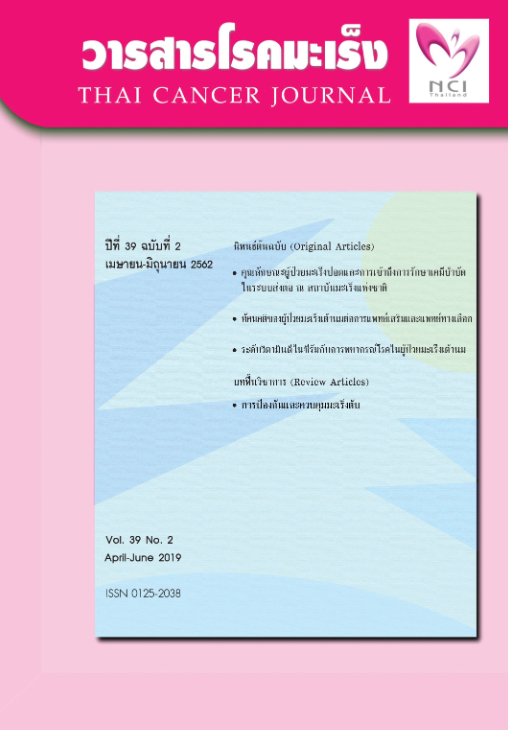Breast Cancer Patients' Attitudes Towards Complementary and Alternative Medicine
Keywords:
complementary and alternative medicine (CAM), breast cancer, attitudes and behaviorsAbstract
The current trend towards the use of complementary and alternative medicine (CAM) is increasing. Some patients believe that it will help to reduce the complications or side effects from primary treatment or even replace primary treatment completely. The purposes of this research were to evaluate the attitudes and behaviors towards using CAM among breast-cancer patients treated at the National Cancer Institute. The subjects were 1150 breast-cancer patients who were asked to complete a questionnaire consisting of 3 parts: personal questionnaire, questionnaire on behaviors regarding the use of CAM, and questionnaire on attitudes towards using CAM. The study indicated that 27.9 % of the sampled breast-cancer patients used CAM. The most frequently used CAMs were herbs and vitamin supplements, at 55.14 % and 30.53 %, respectively. 48.9 % of the patients used CAM for disease treatment and 50.2 % of patients reported positive effects and no side effects from CAM. Regarding attitudes towards CAM, the majority of patients (62 %) disclosed to their doctors that they used CAM. Overall, the patients had moderate attitudes towards CAM. In addition, most patients still believed in modern medical treatment and lacked confidence in CAM. Therefore, developing and transferring knowledge to the public is necessary to choose the most effective treatment, patient care, and preventive procedures
References
Imsamran W, Pattatang A, Supattagorn P, Chiawiriyabunya I, Namthaisong K, Wongsena M, et al. Cancer in Thailand. Vol IX, 2013-2015. Bangkok: 2018.
คณะแพทยศาสตร์ศิริราชพยาบาล. มะเร็งเต้านม เรื่องที่น่ารู้และข้อควรปฏิบตัิสําหรับผู้ป่วยมะเร็งเต้านม. เข้าถึง ได้จาก: www.si.mahidol.ac.th/th/surgery. สืบค้นเมื่อ วันที่ 30 พฤษภาคม 2560.
Maryam Q, Erin Z, Linda EC. Cancer and Complementary Therapies: Current Trends in Survivors' Interest and Use. Integr Cancer Ther 2018;17:84453.
ฤทธิรงค์ อญัจะนะ, วิภาวดี ลี้มิ่งสวสัดิ์. ความรู้ ทัศนคติ และพฤติกรรมการใช้การแพทย์ทางเลือกของคนไทย. J Sports Sci Health 2016;17:70-83.
อจัฉรา เชียงทอง, อรนุช ภาชื่น, ฉวีวรรณ บุญสุยา, ฉัตรชัย สวัสดิไชย. คุณภาพและการเข้าถึงบริการของโรงพยาบาล การแพทย์แผนไทย. วารสารศูนย์การศึกษาแพทยศาสตร์คลินิก โรงพยาบาลพระปกเกล้า 2560;34:206-21.
Horneber M, Bueschel G, Dennert G, Less D, Ritter E, Zwahlen M. How Many Cancer Patients Use Complementary and Alternative Medicine: A Systematic Review and Meta-analysis. Integr Cancer Ther 2012;11:187-203.
Nguyen LT, Davis RB, Kaptchuk TJ, Phillips RS. Use of Complementary and Alternative Medicine and Selfrated Health Status: Results from a National Survey. J Gen Intern Med 2011;26:399-404.
Chi-Keong O, Sophie P, Gerard CB, Sarah SB. Health Status of People Using Complementary and Alterna tive Medical Practitioner Services in 4 English Counties. Am J Public Health 2002;92:1653-56.
Kucukoner M, Bilge Z, Is?kdogan A, Kaplan MA, Inal A, Urakci Z. Complementary and Alternative Medicine Usage in Cancer Patients in Southeast of Turkey. Afr J Tradit Complement Altern Med 2012;10:21-5.
เยาวภา ปฐมศิริกุล, โชติรัส ชวนิชย ์, เริ่ม ใสแจ่ม. พฤติกรรมด้านสุขภาพและปัจจัยจิตวิทยาที่ส่งผลต่อการตัดสินใจใช้บริการด้านสขุภาพด้วยวิธีการแพทย์ทางเลือกของลกูค้าโรงพยาบาลบ้านนา จังหวัดนครนายก. วารสารศรีนครินทรวิโรฒวิจัยและพัฒนา (สาขามนุษยศาสตร์และสังคม ศาสตร์) 2557;6:149-62.
เพลินพิศ เชื้ออ่อน, สุรางค์ เมรานนท์, สุทิติ ขัตติยะ. พฤติกรรมสุขภาพของบุคลากรกรมพัฒนาการแพทย์แผนไทยและการแพทย์ทางเลือก กระทรวงสาธารณสุข. วารสารบณัฑติศกึษา มหาวิทยาลยัราชภฏัวไลยอลงกรณ์ ในพระบรมราชปูถัมภ์ 2554;5:97-103.
Wanchai A, Armer JM, Stewart BR. Complementary and Alternative Medicine Use among Women with Breast Cancer: A Systematic Review. Clin J Oncol Nurs 2010;14:E45-55.
เบญจวรรณ พูนธนานิวัฒน์กุล, Rosemary HL, Rachel LH, Elizabeth MW. ประสบการณ์ของผู้ป่วยมะเร็งต่อการใช้ยาสมุนไพรและการรักษาแบบองค์รวม ณ อโรคยศาล วัดคาประมง จังหวัดสกลนคร. การประชุมวิชาการระดับชาติแพทย์แผนไทยภูมิปัญญาของแผ่นดิน วิทยาลัยการสาธารณสขุสิรินธร จังหวัดพิษณโุลก 2559. เข้าถึงได้จาก: https://www.researchgate.net/publication/311454251. สืบค้นเมื่อวันที่ 30 พฤษภาคม 2560.
Andersen RM. Revisiting the Behavioral Model and Access to Medical Care: Does it Matter?. J Health Soc Behav 1995;36:1-10.
King N, Balneaves LG, Levin GT, Nguyen T, Nation JG, Card C, et al. Surveys of Cancer Patients and Cancer Health Care Providers Regarding Complementary Therapy Use, Communication, and Information needs. Integr Cancer Ther 2015;14:515-24.
Kang E, Yang EJ, Kim SM, Chung IY, Han SA, Ku DH, et al. Complementary and Alternative Medicine Use and Assessment of Quality of Life in Korean Breast Cancer Patients: A Descriptive Study. Support Care Cancer 2012;20:461-73.
Songtish D, Akranurakkul P, Chaiaroon W. The Prevalence and Related Factors of Complementary and Alternative Medicine Used in Thai Breast Cancer Patients. J Med Assoc Thai 2015;98 Suppl 10:S1-7.
Roumeliotis GA, Dostaler G, Boyd KU. Complementary and Alternative Medicines and Patients with Breast Cancer: A Case of Mortality and Systematic Review of Patterns of Use in Patients with Breast Cancer. Plast Surg (Oakv) 2017;25:275-83.
Yarney J, Donkor A, Opoku SY, Yarney L, AgyemanDuah I, Abakah AC, Asampong E. Characteristics of Users and Implications for the Use Of Complementary and Alternative Medicine in Ghanaian Cancer Patients Undergoing Radiotherapy and Chemotherapy: A Cross-Sectional Study. BMC Complement Altern Med 2013;13:1-9.
Sharma V, Holmes JH, Sarkar IN. Identifying Complementary and Alternative Medicine Usage Information from Internet Resources: A Systematic Review. Methods Inf Med 2016;55:322-32.
Schifano F, Ricciardi A, Corazza O, Deluca P, Davey Z, Rafanelli C, et al. New Drugs of Abuse on the Web: the Role of the Psychonaut Web Mapping Project. Riv Psichiatr 2010;45:88-93.
Downloads
Published
Issue
Section
License
บทความทีตีพิมพ์ในวารสารโรคมะเร็งนี้ถือว่าเป็นลิขสิทธิ์ของมูลนิธิสถาบันมะเร็งแห่งชาติ และผลงานวิชาการหรือวิจัยของคณะผู้เขียน ไม่ใช่ความคิดเห็นของบรรณาธิการหรือผู้จัดทํา







